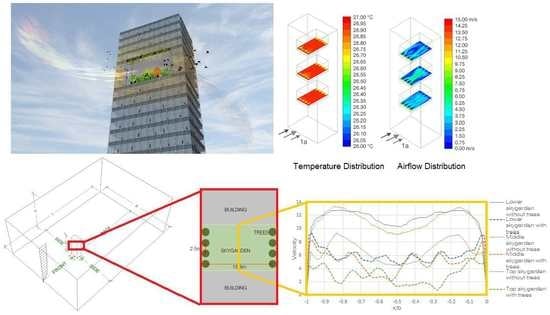Numerical Investigation of the Wind and Thermal Conditions in Sky Gardens in High-Rise Buildings
Abstract
1. Introduction
- Lack of CFD studies to numerically model the airflow distribution patterns in a sky garden and parametrically assess the impact of its configuration.
- Lack of CFD studies to investigate the effect of such airflow distribution on the thermal distribution in these sky gardens.
- Absence of studies investigating the impact of tree configuration on the aero-thermal performance of the sky garden.
2. Materials and Methods
2.1. CFD Governing Equations
2.2. Computational Domain
2.3. Sky Garden Configuration
2.4. Computational Grid
2.5. Boundary Conditions
2.6. Tree Configuration
3. Results
3.1. Method Verification and Validation
3.1.1 Building Model
3.1.2. Vegetation Modelling Validation
4. Discussion
4.1. Wind Flow through Buildings with Sky Gardens without Vegetation
4.2. Wind Flow through Buildings with Vegetation in Sky Garden
5. Conclusions
- Vegetation, which resists air flow through them, can attenuate the high wind speeds in the sky garden to create a safe environment at occupants’ level. In the central configuration, the mid-height sky garden saw a reduction of nearly 77% in wind speeds at the centre, falling from ~9 m/s to 2 m/s. Similarly, in the periphery configuration, the speeds at the mid sky garden fell from 12 m/s to 2 m/s at the corner, with a reduction of over 80%.
- Trees, apart from acting as buffers, also have the potential to cool the surrounding air within and outside the sky garden. Although a marginal decrease in air temperature is observed in the study based on the set conditions, it illustrates the potential of trees to cool the air in its wake.
- Lower wind speeds further assist the vegetative cooling process of the surrounding air. Sky garden design should aim to reduce the high wind speeds for user wind comfort as well as higher temperature reductions through evapo-transpiration from vegetation. The convective heat losses from occupants is not accounted for in this study.
- Tree density, including its porosity, plays a significant role in buffering the winds. Low porosity and high density will improve its performance. Closely spaced trees will further provide a better wind-breaking mechanism.
- In an actual semi-enclosed space on a high-rise, there will be other elements apart from trees which could modify the air flow. The effect of such features, like parapets, furniture, mechanical devices, etc., could be the focus of future studies.
- Modelling a detailed thermodynamic balance to accurately represent the interaction of leaves with the wind will give better estimates of the induced cooling around the trees. For the sake of simplicity, a constant volumetric cooling power was assumed in this study which was obtained by averaging the cooling capacity of a specific plant over the course of one year.
- Comfort of occupants depends on a lot of parameters apart from wind and temperature. This includes humidity, solar radiation, acclimatization of people, etc. [50]. Future studies could investigate the thermal comfort of occupants on sky gardens, taking into account other factors as well that were not considered in this study.
- Sky gardens come in a variety of shape and geometrical configuration, of which the most common types were studied here. A detailed study of the various existing forms and their assessment on air flow pattern remains to be investigated.
- Given the large number of factors which has an impact on the performance of the sky garden, a sensitivity analysis could be undertaken to understand the relative contribution of each factor.
- Air flow distribution and speeds at higher level above the user plane can be investigated with the idea to integrate renewables like wind turbine to take advantage of high wind speeds.
Supplementary Materials
Author Contributions
Funding
Acknowledgments
Conflicts of Interest
Appendix A


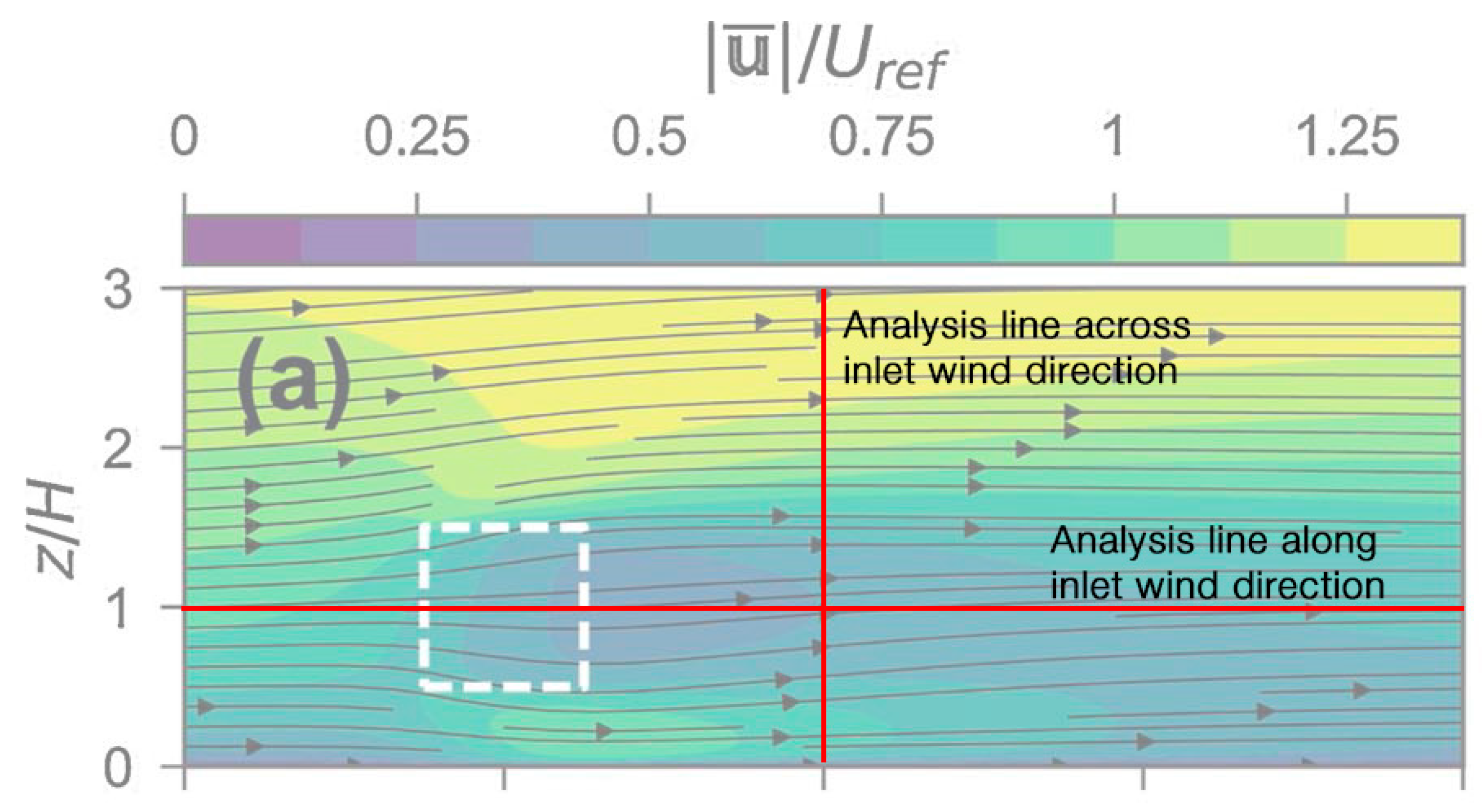
References
- Nooriati, T.; Aldrin, A.; Fadzil, S.S.; Foong, S.Y. An Assessment of Thermal Comfort and Users’ Perceptions of Landscape Gardens in a High-Rise Office Building. J. Sustain. Dev. 2010, 3, 153. [Google Scholar]
- Key World Energy Statistics 2017; International Energy Agency: Paris, France, 2017; p. 97.
- Wilby, R.L. A review of climate change impacts on the built environment. Built Environ. 2007, 33, 31–45. [Google Scholar] [CrossRef]
- Gonçalves, J.C.S. The Environmental Performance of Tall Buildings/Joana Carla Soares Gonçalves with Érica Mitie Umakoshi; Earthscan: London, UK, 2010; ISBN 978-1-84407-812-7. [Google Scholar]
- Firley, E.; Gimbal, J. The Urban Towers Handbook; Wiley: Hoboken, NJ, USA, 2011. [Google Scholar]
- Taha, H. Urban climates and heat islands: Albedo, evapotranspiration, and anthropogenic heat. Energy Build. 1997, 25, 99–103. [Google Scholar] [CrossRef]
- Gao, W. Thermal Effects of Open Space with a Green Area on Urban Environment: Part I: A theoretical analysis and its application. J. Archit. Plan. Environ. Eng. 1993, 448, 15–27. [Google Scholar]
- Yang, A.-S.; Juan, Y.-H.; Wen, C.-Y.; Chang, C.-J. Numerical simulation of cooling effect of vegetation enhancement in a subtropical urban park. Appl. Energy 2017, 192, 178–200. [Google Scholar] [CrossRef]
- Bruse, M.; Fleer, H. Simulating surface–plant–air interactions inside urban environments with a three dimensional numerical model. Environ. Model. Softw. 1998, 13, 373–384. [Google Scholar] [CrossRef]
- Dimoudi, A.; Nikolopoulou, M. Vegetation in the urban environment: Microclimatic analysis and benefits. Energy Build. 2003, 35, 69–76. [Google Scholar] [CrossRef]
- Tian, Y.; Jim, C.Y. Factors influencing the spatial pattern of sky gardens in the compact city of Hong Kong. Landsc. Urban Plan. 2011, 101, 299–309. [Google Scholar] [CrossRef]
- Ong, B.L. Green plot ratio: An ecological measure for architecture and urban planning. Landsc. Urban Plan. 2003, 63, 197–211. [Google Scholar] [CrossRef]
- Niu, J. Some significant environmental issues in high-rise residential building design in urban areas. Energy Build. 2004, 36, 1259–1263. [Google Scholar] [CrossRef]
- Sailor, D.J. A green roof model for building energy simulation programs. Energy Build. 2008, 40, 1466–1478. [Google Scholar]
- Tian, Y.; Jim, C.Y.; Tao, Y. Challenges and Strategies for Greening the Compact City of Hong Kong. J. Urban Plan. Dev. 2012, 138, 101–109. [Google Scholar] [CrossRef]
- Kosareo, L.; Ries, R. Comparative environmental life cycle assessment of green roofs. Build. Environ. 2007, 42, 2606–2613. [Google Scholar]
- Niu, J.L.; Burnett, J. Setting up the criteria and credit-awarding scheme for building interior material selection to achieve better indoor air quality. Environ. Int. 2001, 26, 573–580. [Google Scholar] [CrossRef]
- Turner, S.; Binnie, P.W.H. An indoor air quality survey of twenty-six (26) Swiss office buildings. Environ. Technol. 1990, 11, 303–314. [Google Scholar] [CrossRef]
- Hughes, B.R.; Calautit, J.K.; Ghani, S.A. The development of commercial wind towers for natural ventilation: A revie. Appl. Energy 2012, 92, 606–627. [Google Scholar] [CrossRef]
- Jomehzadeh, F.; Nejat, P.; Calautit, J.; Yusof, M.; Zaki, S.; Hughes, B.; Yazid, M. A review on windcatcher for passive cooling and natural ventilation in buildings. Part 1: Indoor air quality and thermal comfort assessment. Renew. Sustain. Energy Rev. 2017, 70, 736–756. [Google Scholar] [CrossRef]
- Calautit, J.K.; O’Connor, D.; Sofotasiou, P.; Hughes, B.R. CFD Simulation and Optimisation of a Low Energy Ventilation and Cooling System. Computation 2015, 3, 128–149. [Google Scholar] [CrossRef]
- Oberndorfer, E.; Lundholm, J.; Bass, B.; Coffman, R.R.; Doshi, H.; Dunnett, N.; Gaffin, S.; Köhler, M.; Liu, K.K.Y.; Rowe, B. Green Roofs as Urban Ecosystems: Ecological Structures, Functions, and Services. BioScience 2007, 57, 823–833. [Google Scholar] [CrossRef]
- Osmundson, T. Roof Gardens: History, Design, and Construction; W. W. Norton & Company: New York, NY, USA, 2000; ISBN 978-0-393-73012-8. [Google Scholar]
- Buildings Department Environmental Report; Hong Kong Building Department, Publications and Press Releases, 2010. Available online: https://www.bd.gov.hk/doc/en/resources/codes-and-references/notices-and-reports/env_reports/COER2010_eng.pdf (accessed on 25 July 2018).
- Launder, B.E. Turbulence Modelling for CFD. By D. C. WILCOX. DCW Industries Inc., 1993. J. Fluid Mech. 1995, 289, 406–407. [Google Scholar] [CrossRef]
- Kichah, A.; Bournet, P.-E.; Migeon, C.; Boulard, T. Measurement and CFD simulation of microclimate characteristics and transpiration of an Impatiens pot plant crop in a greenhouse. Biosyst. Eng. 2012, 112, 22–34. [Google Scholar] [CrossRef]
- Launder, B.; Spalding, D.B. The Numerical Computation of Turbulent Flow Computer Methods. Comput. Methods Appl. Mech. Eng. 1974, 3, 269–289. [Google Scholar] [CrossRef]
- Ansys 18.2 Documentation; Ansys: Canonsburg, PA, USA, 2017.
- Manickathan, L.; Defraeye, T.; Allegrini, J.; Derome, D.; Carmeliet, J. Parametric study of the influence of environmental factors and tree properties on the transpirative cooling effect of trees. Agric. For. Meteorol. 2018, 248, 259–274. [Google Scholar]
- Rahman, M.A.; Smith, J.G.; Stringer, P.; Ennos, A.R. Effect of rooting conditions on the growth and cooling ability of Pyrus calleryana. Urban For. Urban Green. 2011, 10, 185–192. [Google Scholar] [CrossRef]
- Gromke, C.; Blocken, B.; Janssen, W.; Merema, B.; van Hooff, T.; Timmermans, H. CFD analysis of transpirational cooling by vegetation: Case study for specific meteorological conditions during a heat wave in Arnhem, Netherlands. Build. Environ. 2015, 83, 11–26. [Google Scholar] [CrossRef]
- Amiro, B.D. Comparison of turbulence statistics within three boreal forest canopies. Bound-Layer Meteorol 1990, 51, 99–121. [Google Scholar] [CrossRef]
- Dauzat, J.; Rapidel, B.; Berger, A. Simulation of leaf transpiration and sap flow in virtual plants: Model description and application to a coffee plantation in Costa Rica. Agric. For. Meteorol. 2001, 109, 143–160. [Google Scholar]
- Sanz, C. A Note on k–ε Modelling of Vegetation Canopy Air-Flows. Bound. -Layer Meteorol. 2003, 108, 191–197. [Google Scholar] [CrossRef]
- Sonnenwald, F.; Stovin, V.; Guymer, I. Feasibility of the Porous Zone Approach to Modelling Vegetation in CFD. In Hydrodynamic and Mass Transport at Freshwater Aquatic Interfaces; Rowiński, P., Marion, A., Eds.; Springer International Publishing: Cham, Switzerland, 2016; pp. 63–75. ISBN 978-3-319-27749-3. [Google Scholar]
- Mochida, A.; Murakami, S.; Shoji, M.; Ishida, Y. Numerical Simulation of flowfield around Texas Tech Building by Large Eddy Simulation. J. Wind Eng. Ind. Aerodyn. 1993, 46–47, 455–460. [Google Scholar]
- Franke, J.; Hirsch, C.; Jensen, A.G.; Krüs, H.W.; Schatzmann, M.; Westbury, P.S.; Miles, S.D.; Wisse, J.A.; Wright, N.G. Recommendations on the Use of CFD in Wind Engineering. 2004. Available online: https://www.kuleuven.be/bwf/projects/annex41/protected/data/Recommendations%20for%20CFD%20in%20wind%20engineering.pdf (accessed on 25 July 2018).
- Huang, S.; Li, Q.S.; Xu, S. Numerical evaluation of wind effects on a tall steel building by CFD. J. Constr. Steel Res. 2007, 63, 612–627. [Google Scholar] [CrossRef]
- Tominaga, Y.; Mochida, A.; Murakami, S.; Sawaki, S. Comparison of various revised k–ε models and LES applied to flow around a high-rise building model with 1:1:2 shape placed within the surface boundary layer. J. Wind Eng. Ind. Aerodyn. 2008, 96, 389–411. [Google Scholar] [CrossRef]
- Agerneh, K.D.; Bitsuamalk, G.T.; Merrick, R. Computational Evaluation of Wind Pressures on Tall Buildings. In Proceedings of the 11th Americas Conference on Wind Engineering, San Juan, Puerto Rico, 22–26 June 2009. [Google Scholar]
- Revuz, J. Numerical Simulation of the Wind Flow around a Tall Building and Its Dynamic Response to Wind Excitation. Ph.D. Thesis, University of Nottingham, Nottingham, UK, 2011. [Google Scholar]
- Pomeroy, J. The Skycourt and Skygarden: Greening the Urban Habitat/Jason Pomeroy; Routledge: Abingdon, UK, 2014; ISBN 978-0-415-63698-8. [Google Scholar]
- Carter, T.; Keeler, A. Life-cycle cost–benefit analysis of extensive vegetated roof systems. J. Environ. Manag. 2008, 87, 350–363. [Google Scholar] [CrossRef] [PubMed]
- Yang, J.; Yu, Q.; Gong, P. Quantifying air pollution removal by green roofs in Chicago. Atmos. Environ. 2008, 42, 7266–7273. [Google Scholar]
- Richards, P.J.; Norris, S.E. Appropriate boundary conditions for computational wind engineering models revisited. J. Wind Eng. Ind. Aerodyn. 2011, 99, 257–266. [Google Scholar] [CrossRef]
- Braun, A.L.; Awruch, A.M. Aerodynamic and aeroelastic analyses on the CAARC standard tall building model using numerical simulation. Comput. Struct. 2009, 87, 564–581. [Google Scholar] [CrossRef]
- Neufert, E.; Neufert, P. Architects’ Data, 3rd ed.; Baiche, B., Walliman, N., Eds.; Blackwell Science: Oxford, UK; Malden, MA, USA, 2000; ISBN 978-0-632-03776-6. [Google Scholar]
- Wind Comfort and Wind Danger in the Built Environment. Available online: https://infostore.saiglobal.com/en-gb/standards/nen-8100-2006-356708/ (accessed on 27 August 2018).
- Lawson, T.V. The wind content of the built environment. J. Wind Eng. Ind. Aerodyn. 1978, 3, 93–105. [Google Scholar] [CrossRef]
- Givoni, B.; Noguchi, M.; Saaroni, H.; Pochter, O.; Yaacov, Y.; Feller, N.; Becker, S. Outdoor comfort research issues. Energy Build. 2003, 35, 77–86. [Google Scholar] [CrossRef]
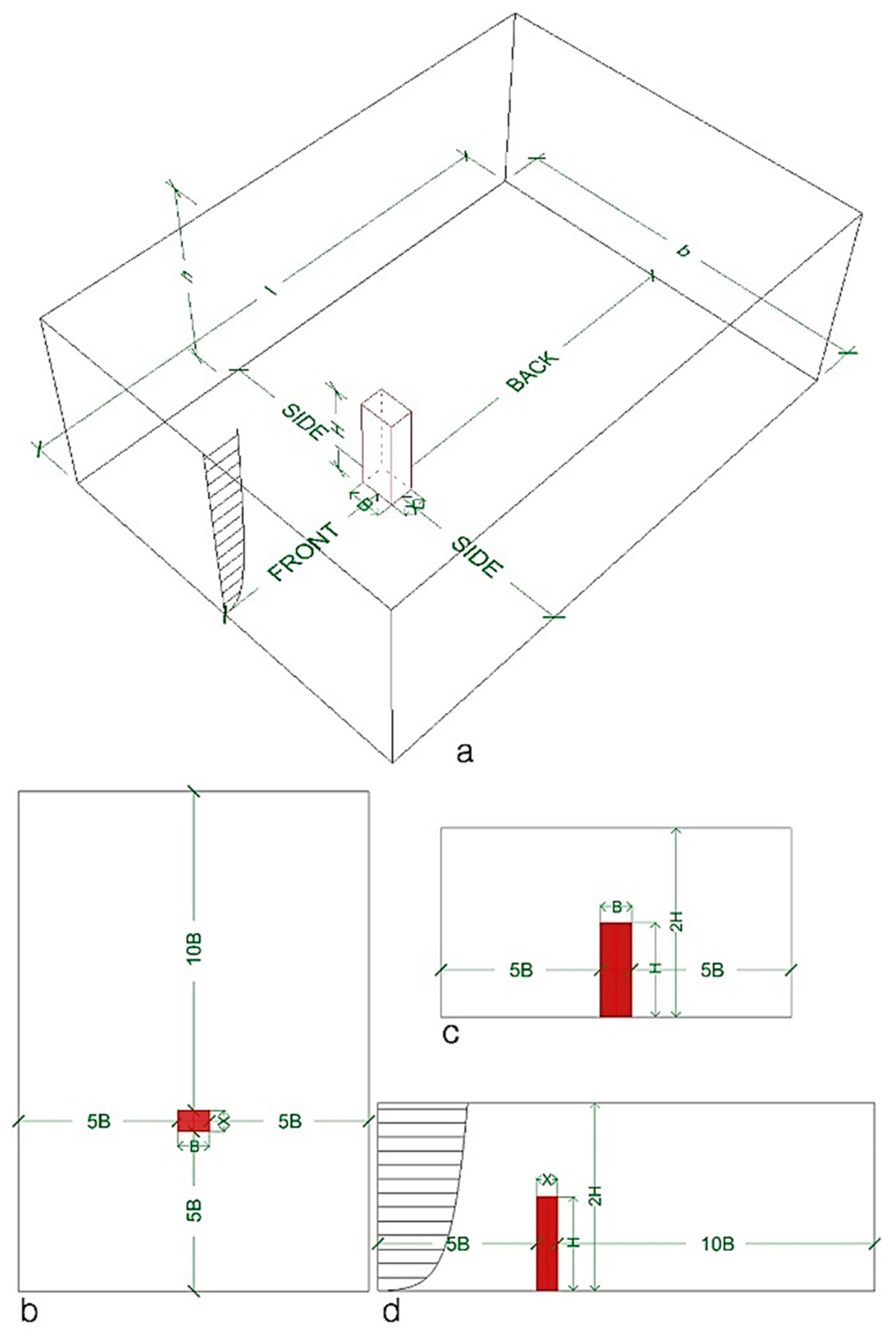


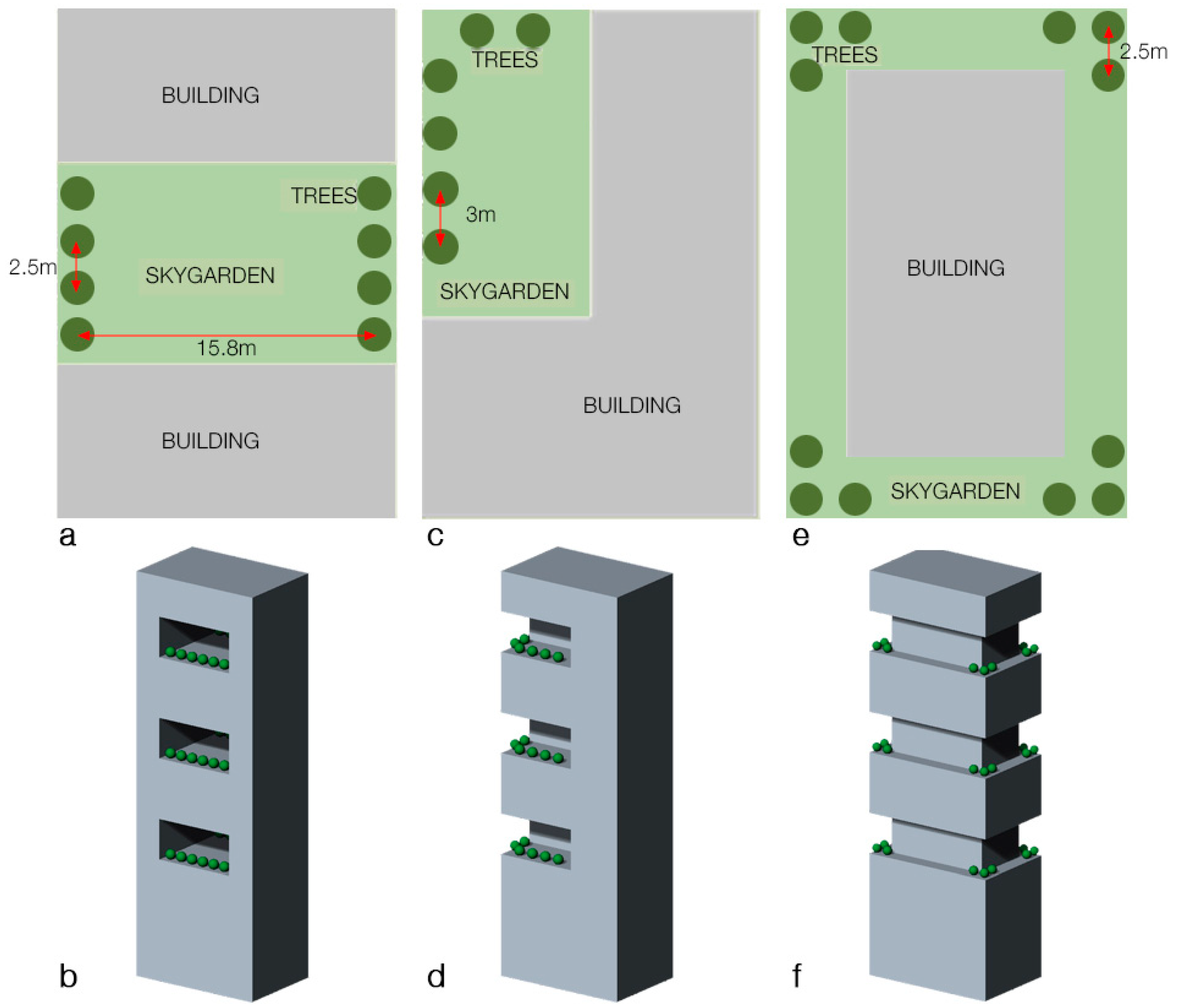
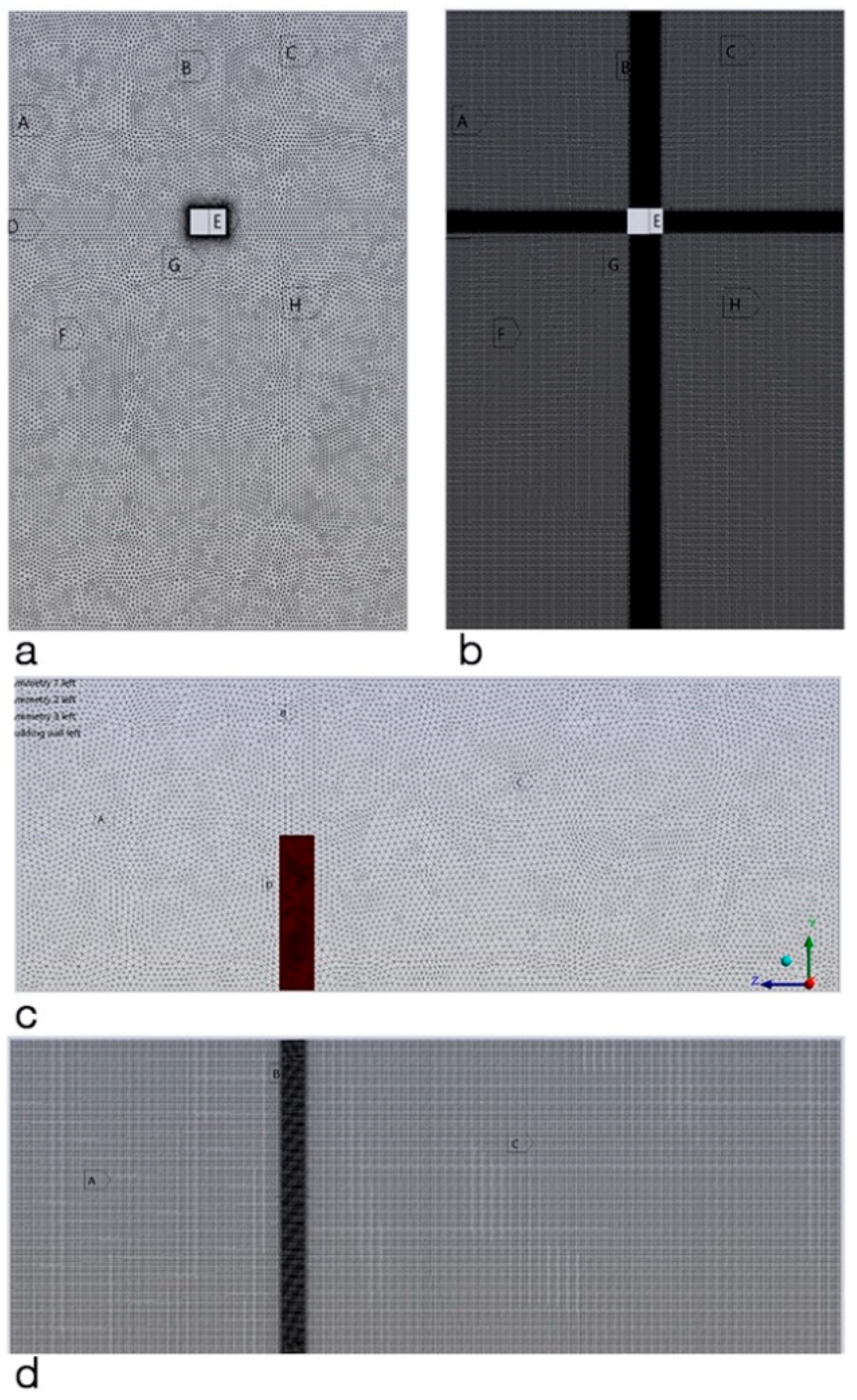
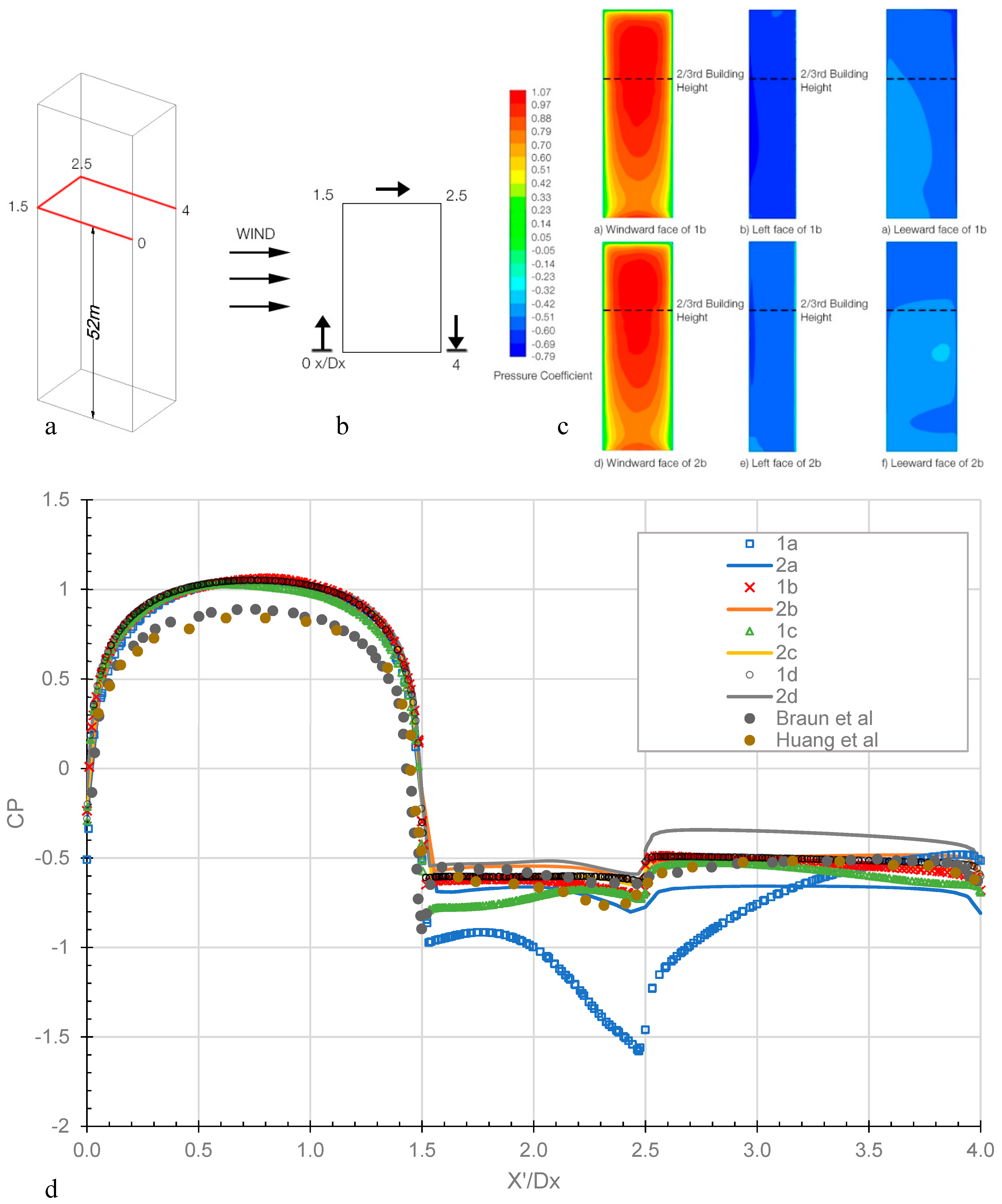
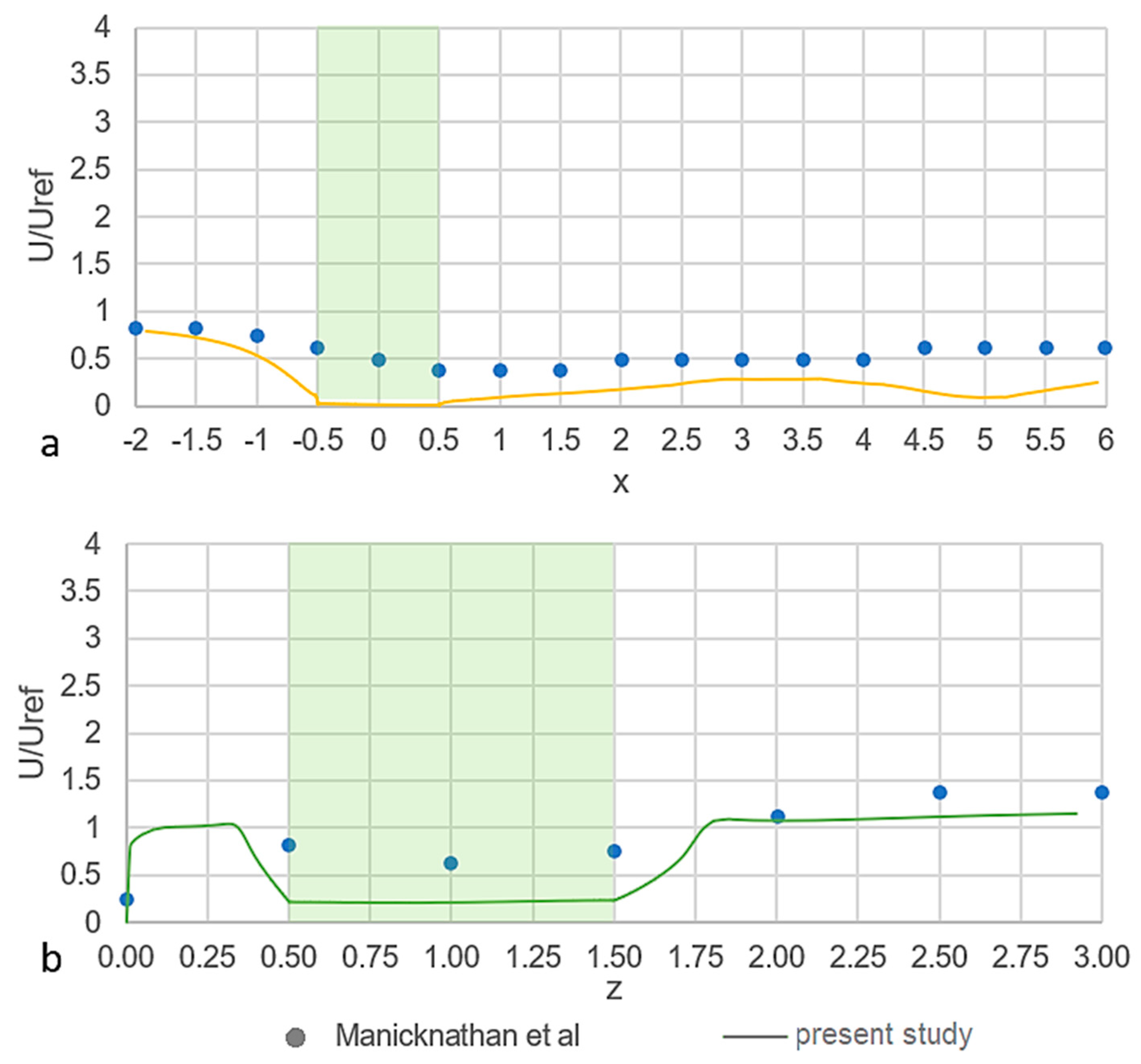
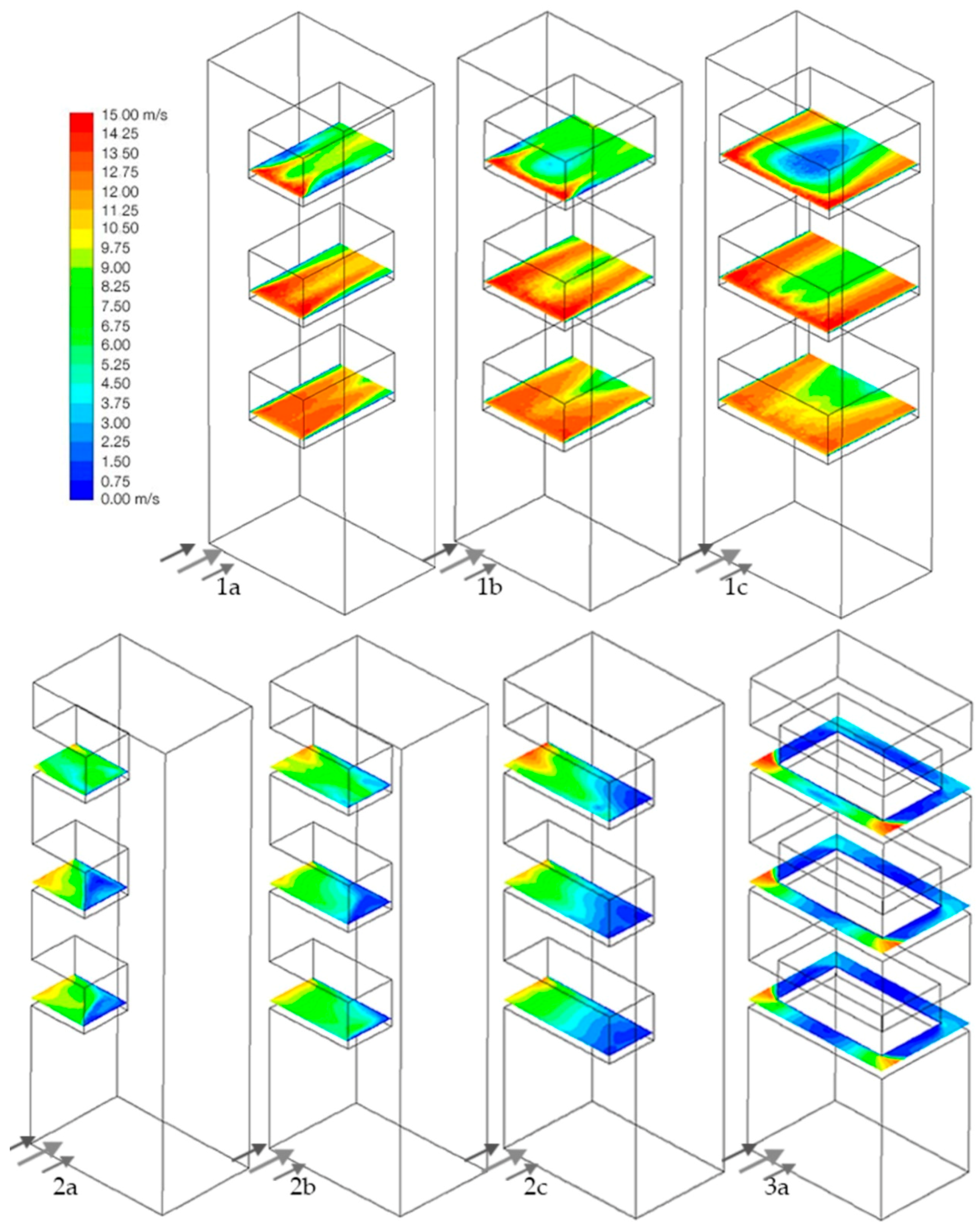
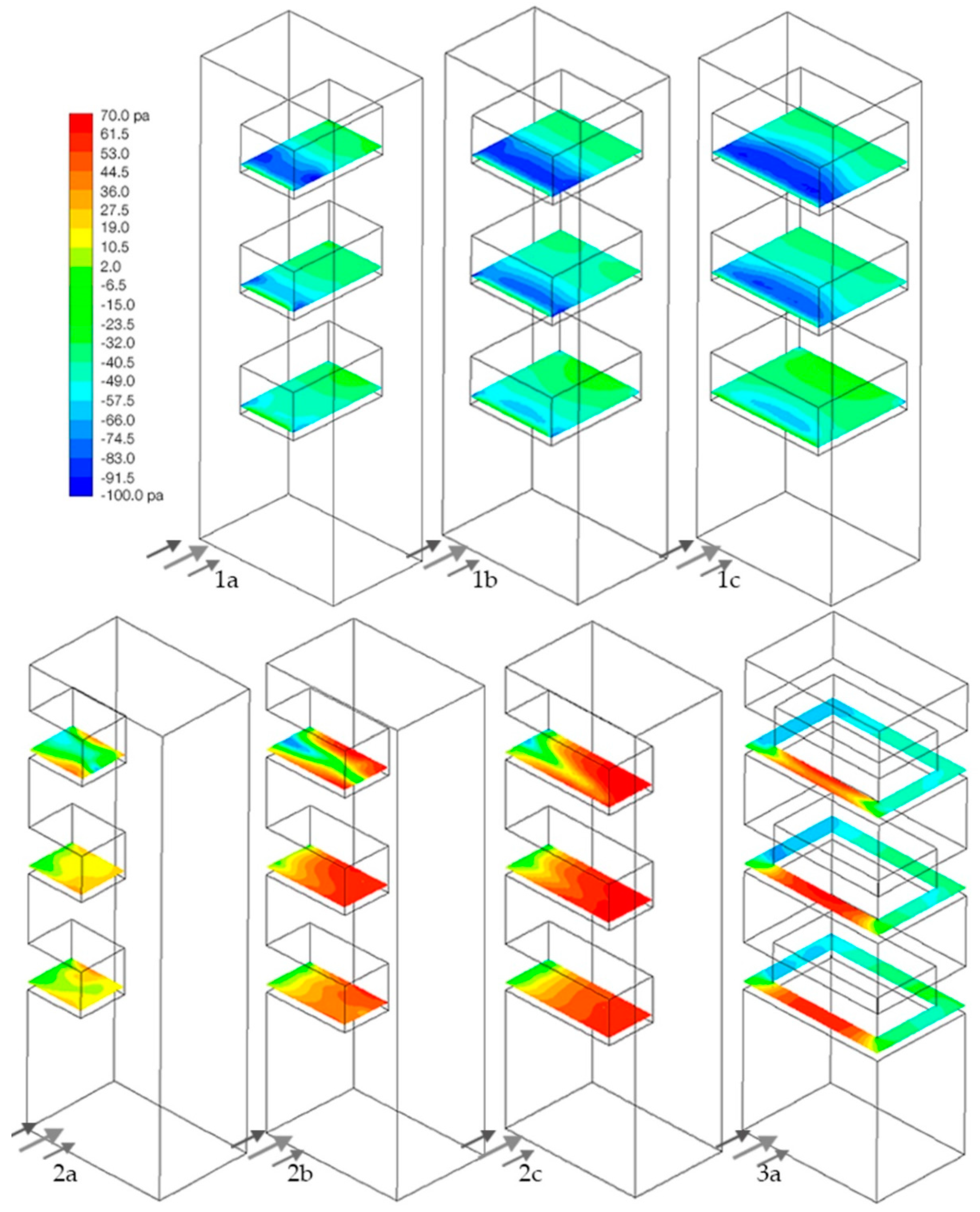
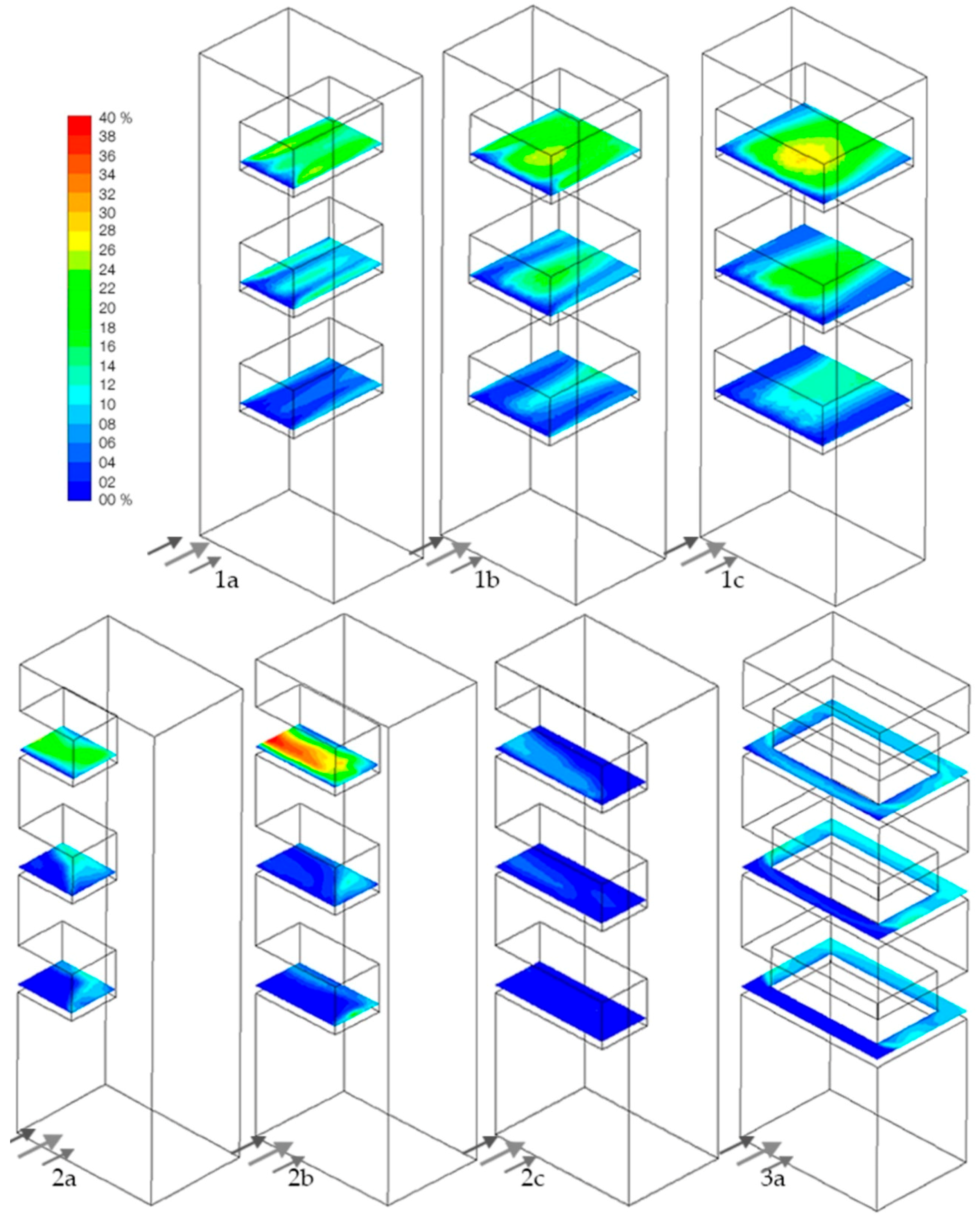
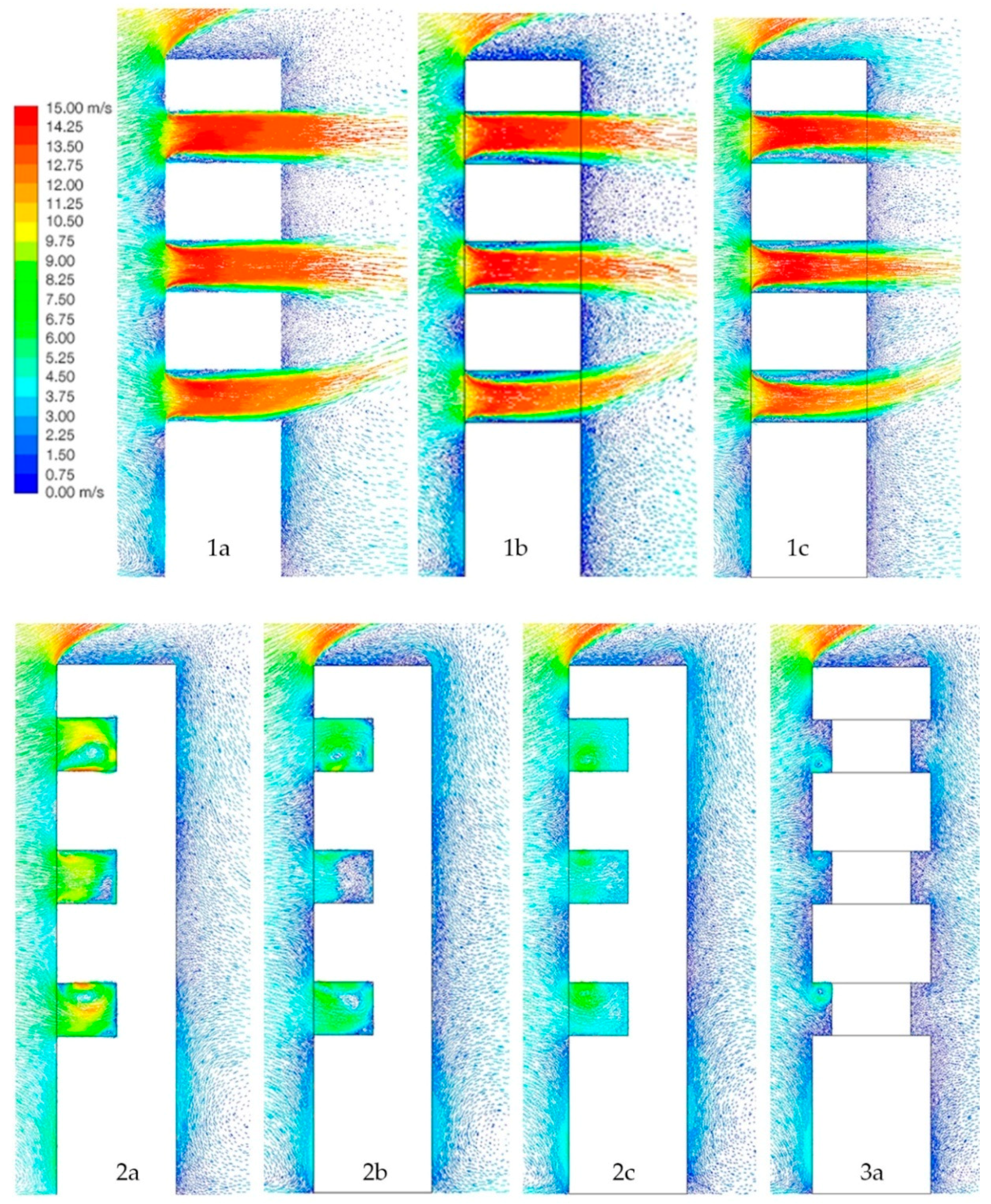
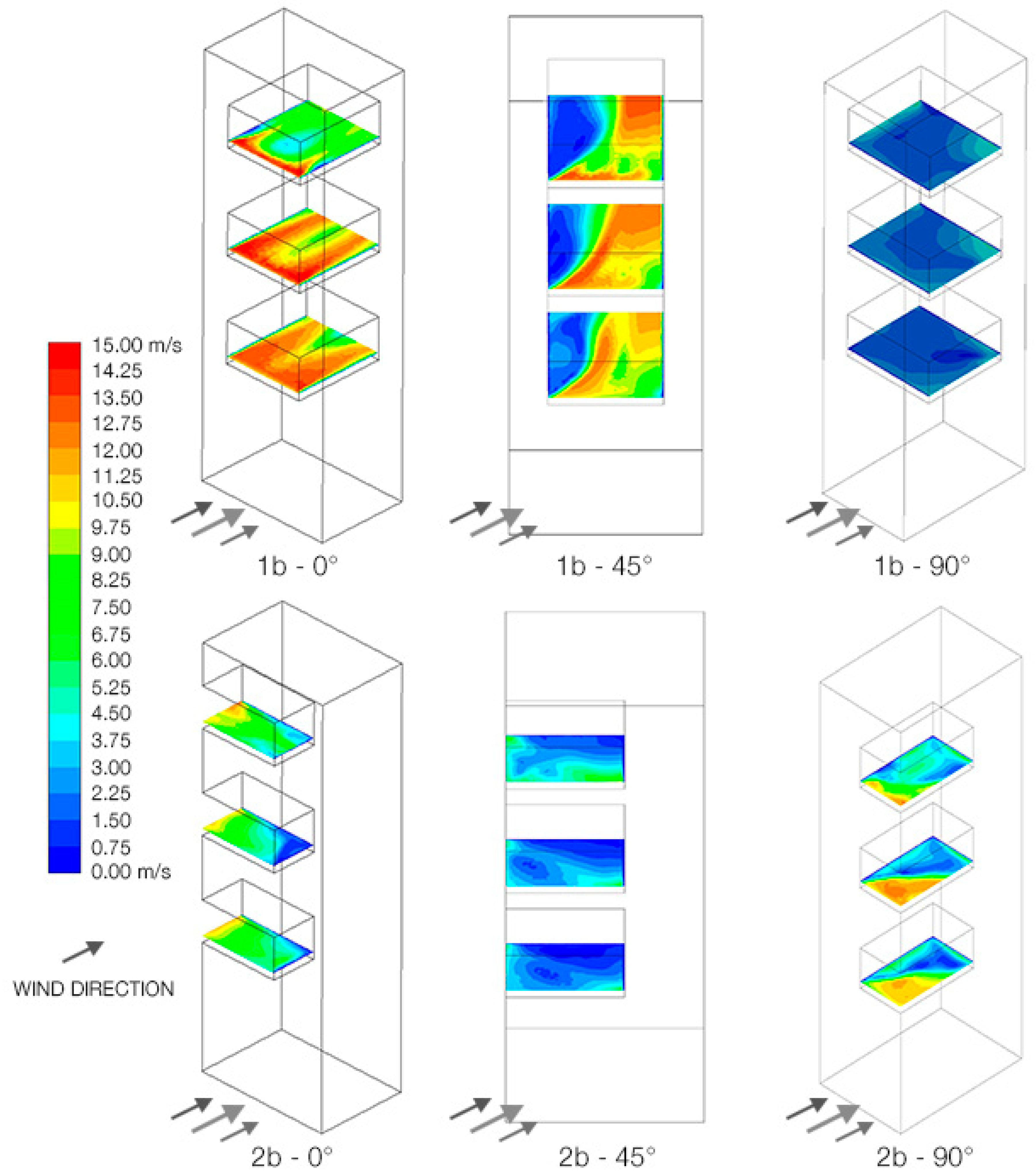
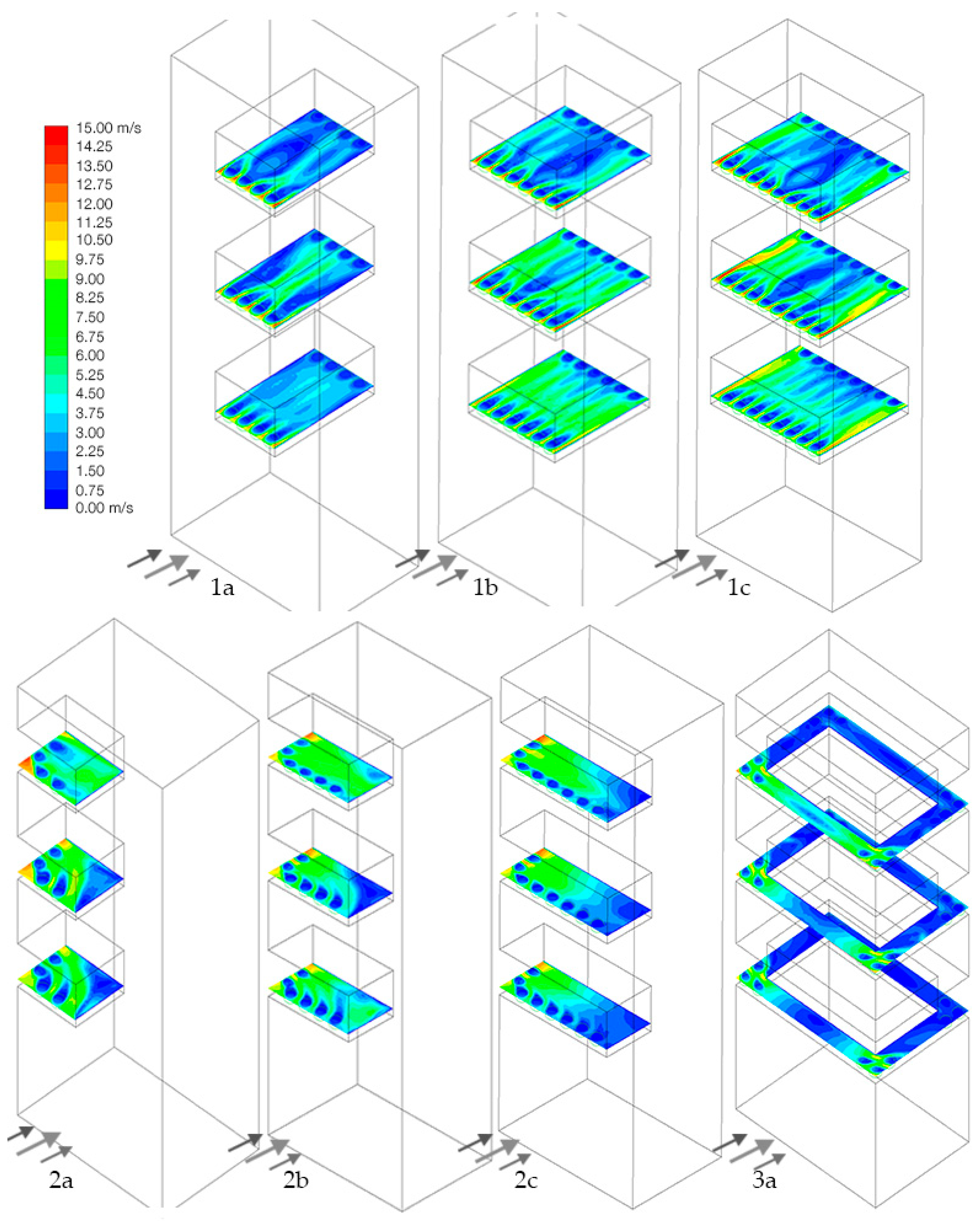
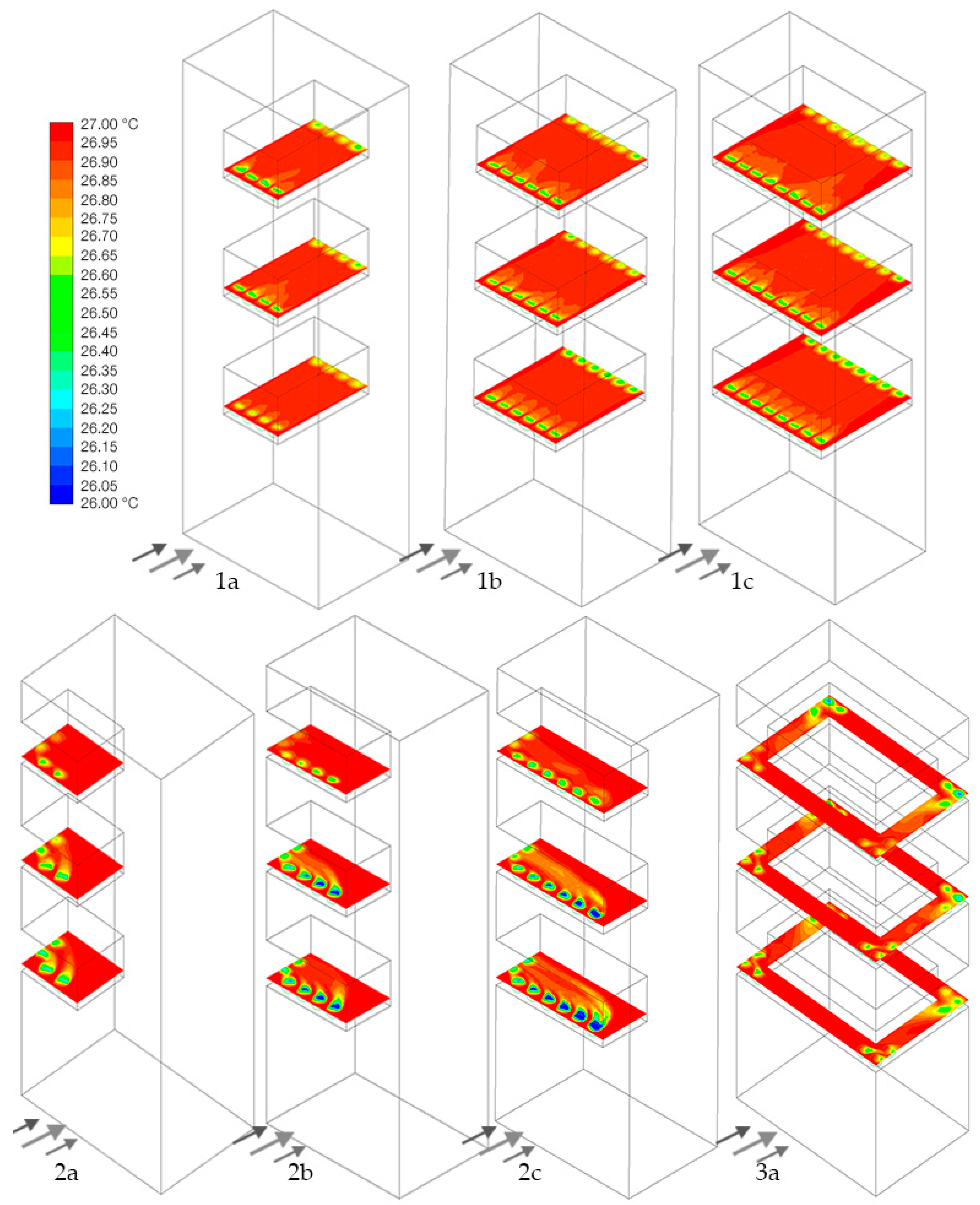
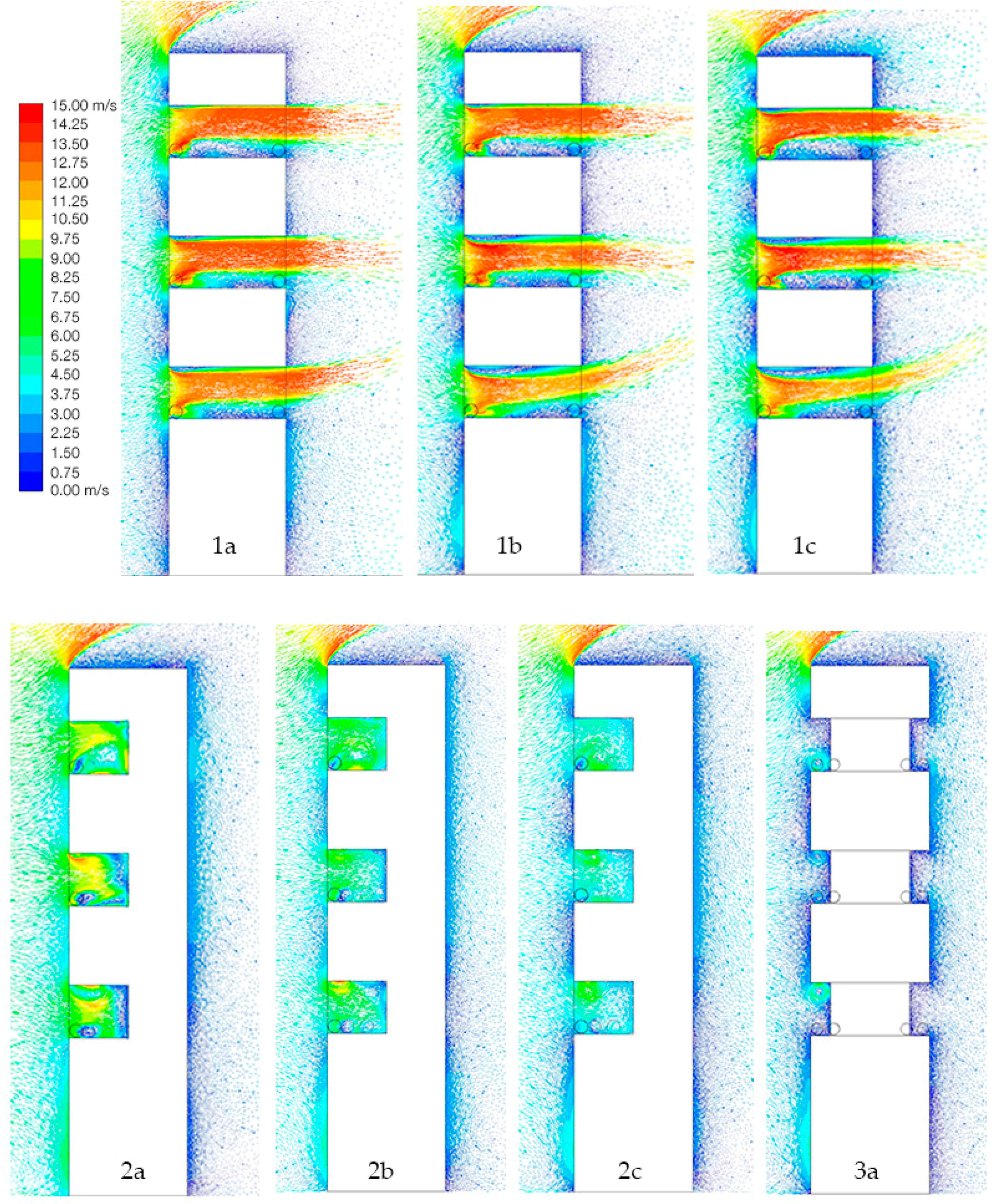
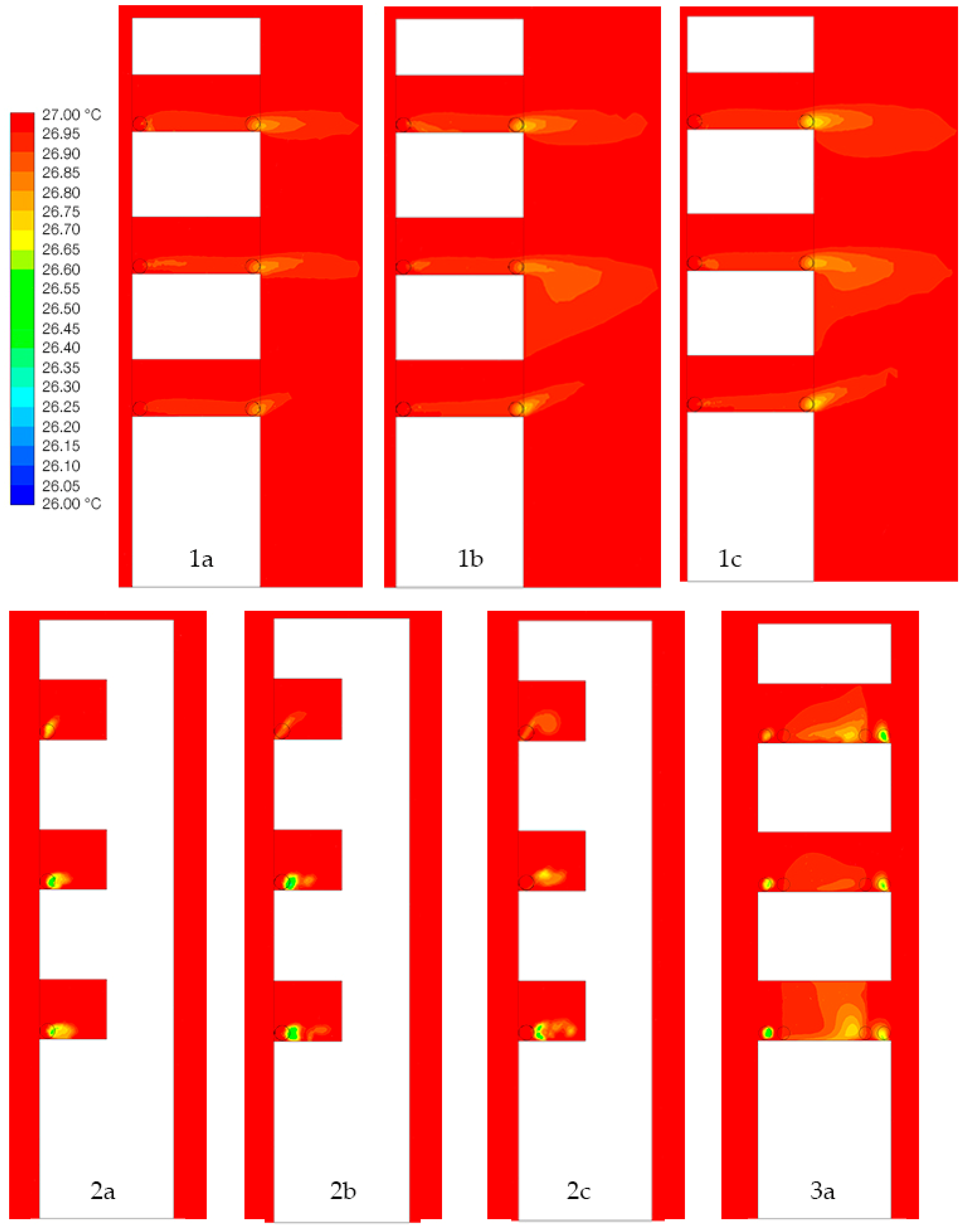
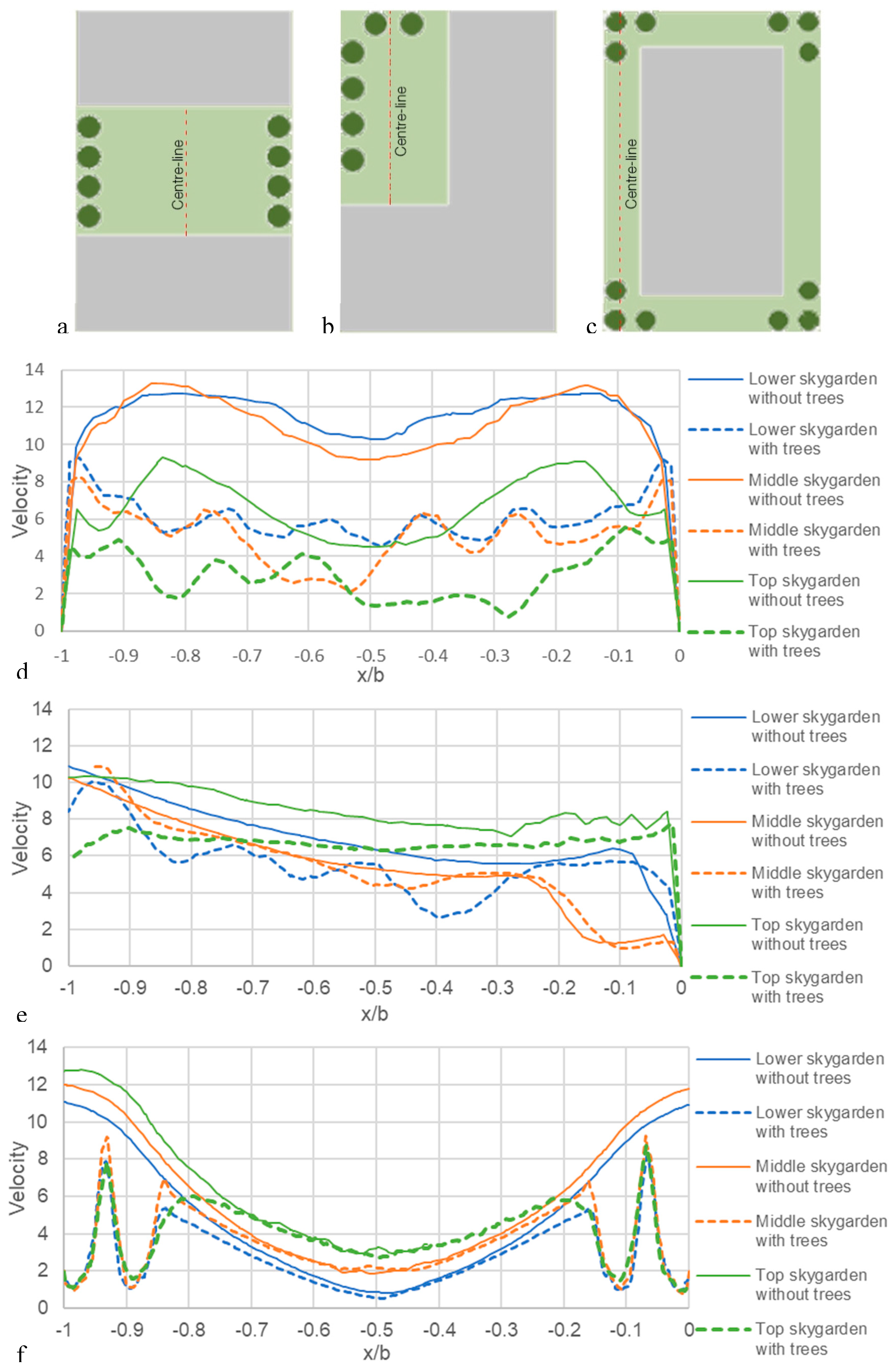
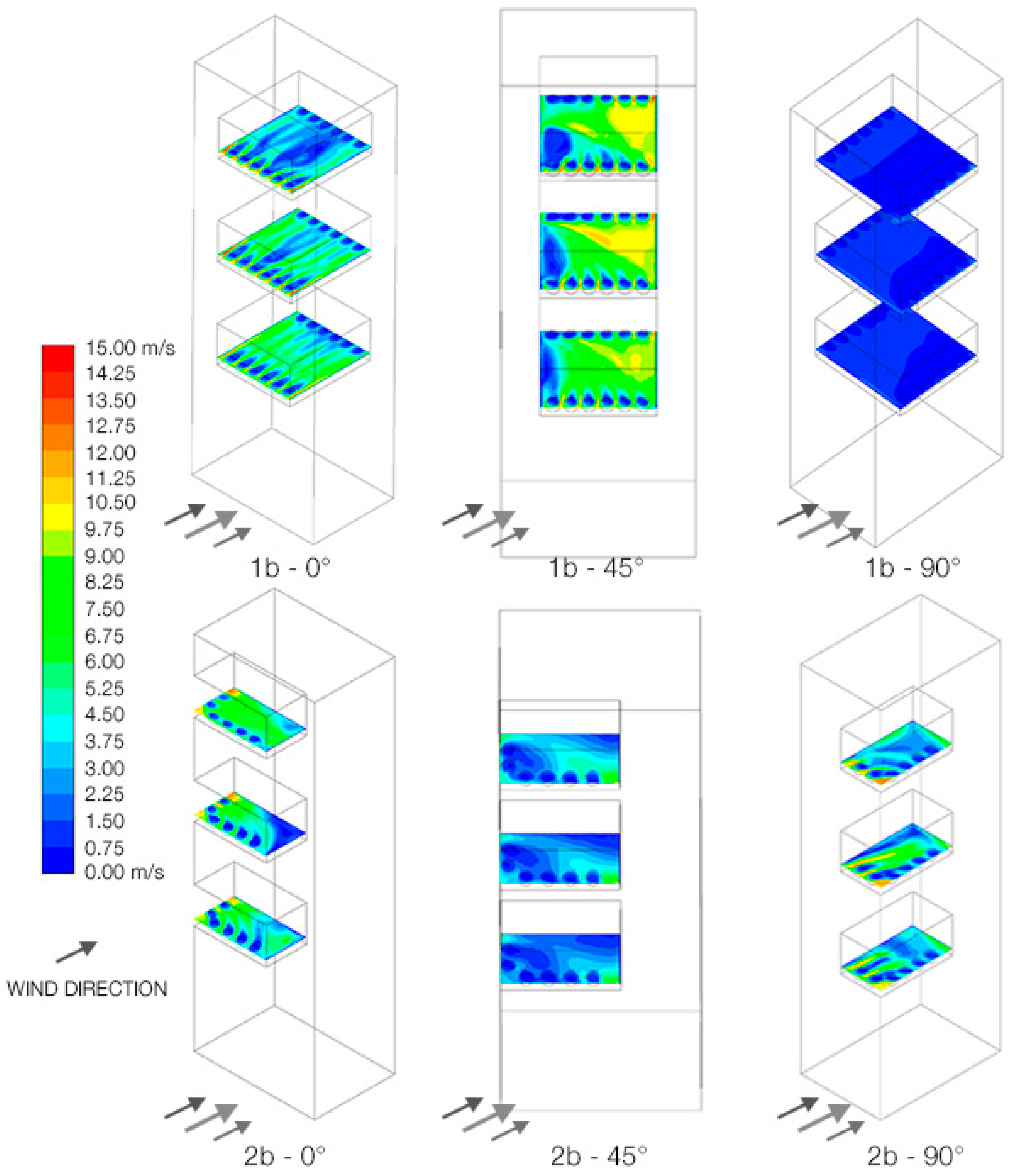
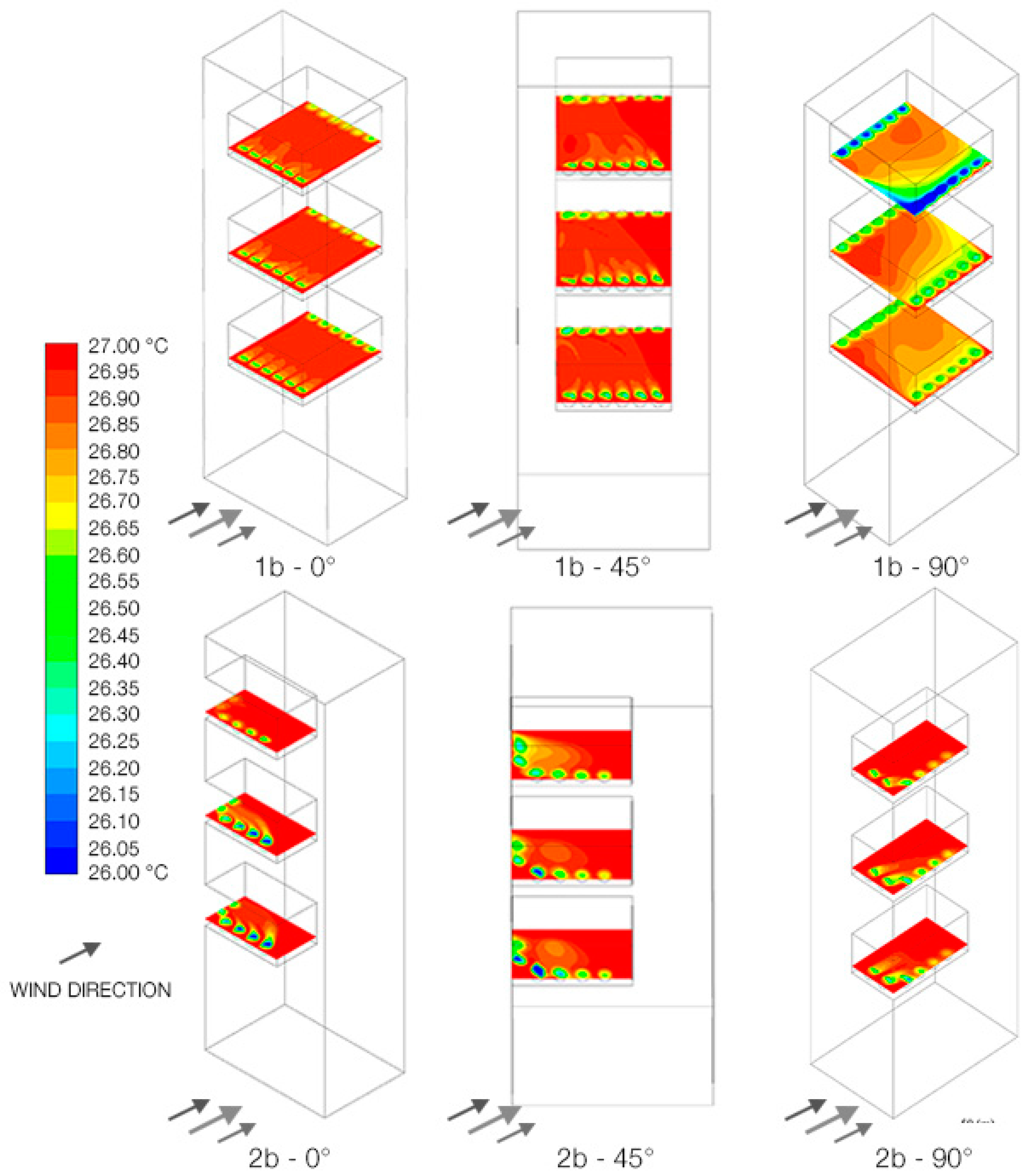
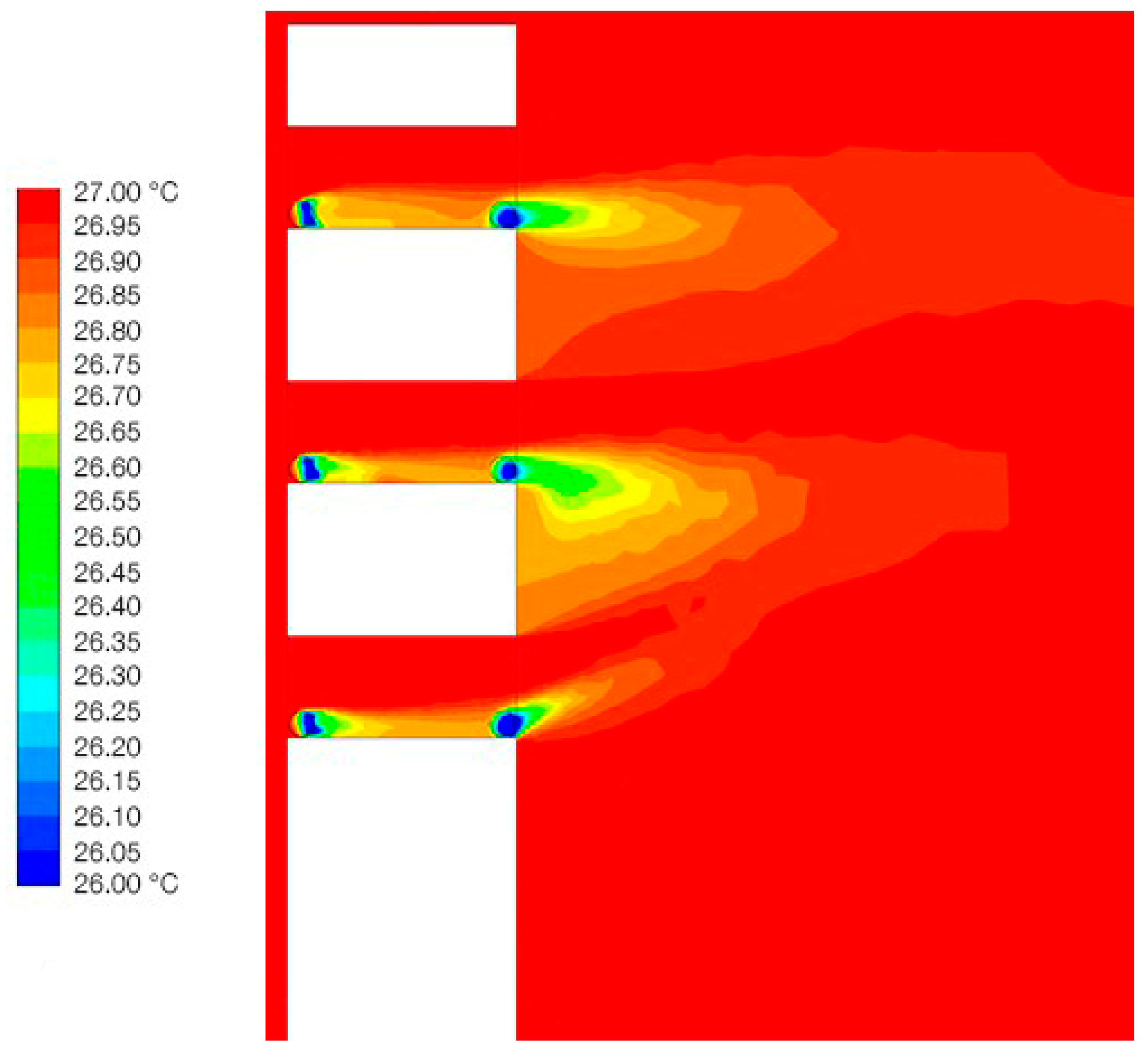
| Study | Domain Size | Building | ||
|---|---|---|---|---|
| l (front + X + back) | b (side + B + side) | h | H (mts) | |
| Mochida et al. [36] | 10.8H | 6.9H | 5.6H | 0.16 |
| Franke et al. [37] | 5H + X + 15H | 5H + B + 5H | H + 5H | |
| Huang et al. [38] | 1.5H + X + 5.5H | 2H + B + 2H | 2H | 183 |
| Tominaga et al. [39] | 5H + X + 10H | 5H + B + 5H | H + 5H | |
| Agarneh et al. [40] | 8B + X + 25B | 2H | 182 | |
| Revuz [41] | 5B + X + 30B | 13B + B + 13B | 2.5H | |
| Present study | 5B + X + 10B | 5B + B + 5B | 2H | 80 |
| Ratio | Central Sky Garden | ||
| b/B | 0.4 | 0.6 | 0.8 |
 |  |  | |
| 1a | 1b | 1c | |
| Corner sky Garden | |||
| b/B | 0.4 | 0.6 | 0.8 |
 |  |  | |
| 2a | 2b | 2c | |
| Periphery Sky Garden | |||
| a/A | 0.5 | ||
 | |||
| 3a | |||
| Parameter | Central Sky Garden | Corner Sky Garden | Periphery Sky Garden | ||||
|---|---|---|---|---|---|---|---|
| 1a | 1b | 1c | 2a | 2b | 2c | 3a | |
| Nodes | 444,103 | 453,350 | 461,077 | 428,637 | 433,783 | 439,328 | 434,676 |
| Elements | 2,372,611 | 2,422,894 | 2,465,461 | 2,292,638 | 2,318,895 | 2,348,722 | 2,324,585 |
| Parameter | Unstructured Grid | Structured Grid | ||||||
|---|---|---|---|---|---|---|---|---|
| 1a | 1b | 1c | 1d | 2a | 2b | 2c | 2d | |
| Nodes | 269,743 | 536,188 | 747,087 | 1,318,186 | 318,324 | 475,661 | 756,114 | 1,462,334 |
| Elements | 1,455,479 | 2,876,892 | 4,033,941 | 7,244,442 | 1,712,822 | 2,518,223 | 3,970,220 | 7,648,310 |
| Threshold of Wind Speed | Quality Class | Original Description | Reference Activity |
|---|---|---|---|
| U > 1.8 m/s | A | Covered area | Sitting long |
| U > 3.6 m/s | B | Pedestrian stand around | Sitting short |
| U > 5.3 m/s | C | Pedestrian walk through | Strolling |
| U > 7.6 m/s | D | Roads and car parks | Walking fast |
| U > 15 m/s | E | Dangerous | Unacceptable |
© 2019 by the authors. Licensee MDPI, Basel, Switzerland. This article is an open access article distributed under the terms and conditions of the Creative Commons Attribution (CC BY) license (http://creativecommons.org/licenses/by/4.0/).
Share and Cite
Mohammadi, M.; Calautit, J.K. Numerical Investigation of the Wind and Thermal Conditions in Sky Gardens in High-Rise Buildings. Energies 2019, 12, 1380. https://doi.org/10.3390/en12071380
Mohammadi M, Calautit JK. Numerical Investigation of the Wind and Thermal Conditions in Sky Gardens in High-Rise Buildings. Energies. 2019; 12(7):1380. https://doi.org/10.3390/en12071380
Chicago/Turabian StyleMohammadi, Murtaza, and John Kaiser Calautit. 2019. "Numerical Investigation of the Wind and Thermal Conditions in Sky Gardens in High-Rise Buildings" Energies 12, no. 7: 1380. https://doi.org/10.3390/en12071380
APA StyleMohammadi, M., & Calautit, J. K. (2019). Numerical Investigation of the Wind and Thermal Conditions in Sky Gardens in High-Rise Buildings. Energies, 12(7), 1380. https://doi.org/10.3390/en12071380





